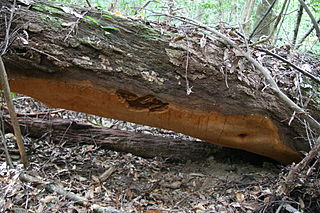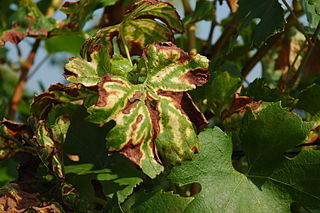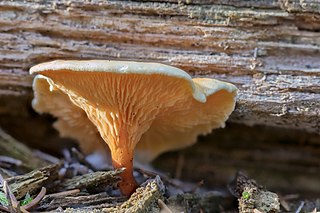
The Polyporaceae are a family of poroid fungi belonging to the Basidiomycota. The flesh of their fruit bodies varies from soft to very tough. Most members of this family have their hymenium in vertical pores on the underside of the caps, but some of them have gills or gill-like structures. Many species are brackets, but others have a definite stipe – for example, Polyporus badius.

The Agaricomycetes are a class of fungi in the division Basidiomycota. The taxon is roughly identical to that defined for the Homobasidiomycetes by Hibbett & Thorn, with the inclusion of Auriculariales and Sebacinales. It includes not only mushroom-forming fungi, but also most species placed in the deprecated taxa Gasteromycetes and Homobasidiomycetes. Within the subdivision Agaricomycotina, which already excludes the smut and rust fungi, the Agaricomycetes can be further defined by the exclusion of the classes Tremellomycetes and Dacrymycetes, which are generally considered to be jelly fungi. However, a few former "jelly fungi", such as Auricularia, are classified in the Agaricomycetes. According to a 2008 estimate, Agaricomycetes include 17 orders, 100 families, 1147 genera, and about 21000 species. Modern molecular phylogenetic analyses have been since used to help define several new orders in the Agaricomycetes: Amylocorticiales, Jaapiales, Stereopsidales, and Lepidostromatales.
Abundisporus is a small genus of poroid fungi currently with seven recognized species. They differ from other polypores in having coloured rather than hyaline spores.

The Hymenochaetaceae are a family of fungi in the order Hymenochaetales. The family contains several species that are implicated in many diseases of broad-leaved and coniferous trees, causing heart rot, canker and root diseases, and also esca disease of grapevines. According to a standard reference text, the family contains 27 genera and 487 species.

Fomitiporia is a genus of fungi in the family Hymenochaetaceae. According to a 2008 estimate, the widely distributed genus contains 11 species, though three new species were identified in 2010 in sub-Saharan Africa using multigene molecular phylogenetic analysis, and two more were named in a 2013 article. In 2011 it was announced that a specimen of the species F. ellipsoidea was discovered with a fruit body that is largest known of any fungus. However, the species has since been moved to Phellinus.

Phylloporia is a genus of polypore fungi in the family Hymenochaetaceae. A 2012 estimate placed 23 species in the genus; this number was increased to 30 by 2015.

Antrodia is a genus of fungi in the family Fomitopsidaceae. Antrodia species have fruit bodies that typically resupinate, with the hymenium exposed to the outside; the edges may be turned so as to form narrow brackets. Most species are found in temperate and boreal forests, and cause brown rot.

Phellinus ellipsoideus is a species of polypore fungus in the family Hymenochaetaceae, a specimen of which produced the largest fungal fruit body ever recorded. Found in China, the fruit bodies produced by the species are brown, woody basidiocarps that grow on dead wood, where the fungus feeds as a saprotroph. The basidiocarps are perennial, allowing them to grow very large under favourable circumstances. They are resupinate, measuring 30 centimetres (12 in) or more in length, though typically extending less than a centimetre from the surface of the wood. P. ellipsoideus produces distinct ellipsoidal spores, after which it is named, and unusual setae. These two features allow it to be readily differentiated microscopically from other, similar species. Chemical compounds isolated from the species include several steroidal compounds. These may have pharmacological applications, but further research is needed.

Esca is a grape disease of mature grapevines. It is a type of grapevine trunk disease.
Coniella is a fungus genus in the family Schizoparmeaceae, which contains 65 species recorded in the database Mycobank. This genus Coniella are reported as a typical plant pathogenic fungi for grape, eucalyptus and several plant. It mainly found in Europe, Asian, also South Africa. less report in American, only one paper published new spaces founded.
Fomitiporia mediterranea is a fungus species in the genus Fomitiporia associated with esca of grapevine.

Fibroporia is a genus of ten species of poroid crust fungi in the family Fomitopsidaceae. The genus contains species similar to those in genus Antrodia, but they are phylogenetically distinct.
Tropicoporus tropicalis is part of the family Hymenochaetaceae, and was recently renamed to Tropicoporus tropicalis from Inonotus tropicalis, which is part of the Inonotus clade B. Tropicoporus tropicalis is a wood-decaying basidiomycetes that rarely causes disease in animals and human, and is commonly found in humid climate such as Brazil. In its natural environment, the fungus is associated with white rot woody angiosperms, and has its annual fruiting body on tree trunks and branches. Tropicoporus tropicalis has two kinds of hyphae, generative and skeletal, that lack clamp connections.
Fomitiporia nobilissima is a fungus in the family Hymenochaetaceae. Found in Gabon, it was described as new to science in 2010.
Fomitiporia ivindoensis is a fungus in the family Hymenochaetaceae. It was first isolated from Sub-Saharan Africa, specifically in the Guineo-Congolian forest. It has a pileate basidiome, small basidiospores and an absence of setae. Morphological features that differentiate this species with F. nobilissima and F. gabonensis are its pileus' shape, pore surface color and diameter, as well as its ecology.

Morchella dunensis, the morel of the dunes, is a species of fungus in the family Morchellaceae (Ascomycota). It was first described as a form of Morchella esculenta by Castañera and colleagues in 1996, but was later recombined as a distinct species by Clowez. In a 2014 study by Richard and colleagues, the authors concluded that the taxon was conspecific to Morchella vulgaris, due to its close phylogenetic proximity to the latter. However, following increased molecular sampling and the testing of an isoparatype collection by Loizides and colleagues in 2016, it was revealed that M. dunensis is indeed very closely related to, but phylogenetically distinct from M. vulgaris. This study also showed that the taxon Morchella andalusiae is phylogenetically identical and therefore a later synonym of M. dunensis.
Neosporidesmium malloti is a species of anamorphic ascomycete fungi, first found in tropical forests in Hainan, China, specifically in dead branches of Mallotus hookerianus, hence its name.
Truncospora is a genus of 10 species of fungi in the family Polyporaceae.

The Guineo-Congolian region is a biogeographical region in Africa straddling the Equator and stretching from the Atlantic Ocean through the Congo Basin to the Congo / Nile divide in Rwanda and Burundi. Formerly, this region was largely covered in rain forest, on both well-drained sites and in swamp forests, but little undisturbed primary forest now remains, having been replaced in many areas by savanna and secondary-growth forest.

Bonomyces is a genus of fungi in the family Biannulariaceae. Basidiocarps are agaricoid, similar to those of Clitocybe, but with a distinctly hard stipe (stem). The genus is separated on DNA characteristics as well as morphology. Species are known from Europe, North Africa, and northern China.











